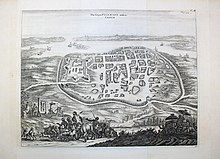Pulicat
This article needs additional citations for verification. (May 2013) |
Pulicat
Pazhaverkadu | |
|---|---|
town | |
UTC+5:30 (IST ) |
Pulicat or Pazhaverkadu is a historic seashore town in
History


The
Aadhi Narayana Perumal temple is an old temple located at Pazhaverkadu.[1]
Pulicat-Day is celebrated on World Wetland Day (2 February) at Pulicat by AARDE Foundation. Famous traditional catamaran competition and several competitions are held on this day. Small information center (Pulicat Museum) at Pazhaverkadu gives detailed information on Pulicat ecology and built heritage.
Fort Geldria
Fort Geldria or Fort Geldaria, located in Pulicat, was the seat of the Dutch Republic's first settlement in India, and the capital of Dutch Coromandel.[2] It was built by the Dutch East India Company in 1613 and became the local governmental centre in 1616.[3] It was named for Geldria, the native province of Wemmer van Berchem, the General Director of the company.[4] Regularly protected by a garrison of 80 to 90 men,[5] Fort Geldria was the only fortification in the Indian empire;[6] all other positions of the Dutch Company were trading posts.[6]
Wildlife
Pulicat is within the Pulicat Lake Bird Sanctuary. Every year between the months of October and March, thousands of migratory birds land here. Though many species can be seen, the Flamingos are the most visible, covering the swamps surrounding the lake, giving it a pink tinge.[citation needed]
References
- ^ "Poor conservation process harming temples in Tamil Nadu: Unesco's report to Madras HC". scroll.in. 9 August 2017. Retrieved 13 December 2018.
- ^ Muthiah, S. (2 July 2001). "Madras Miscellany". The Hindu. Archived from the original on 26 March 2002. Retrieved 18 February 2010.
- OCLC 489951836.
- ^ James 2009, p. 34
- ISBN 978-0-226-46767-2. Retrieved 18 February 2010.
- ^ a b James 2009, p. 32
External links
![]() Media related to Pulicat at Wikimedia Commons
Media related to Pulicat at Wikimedia Commons
